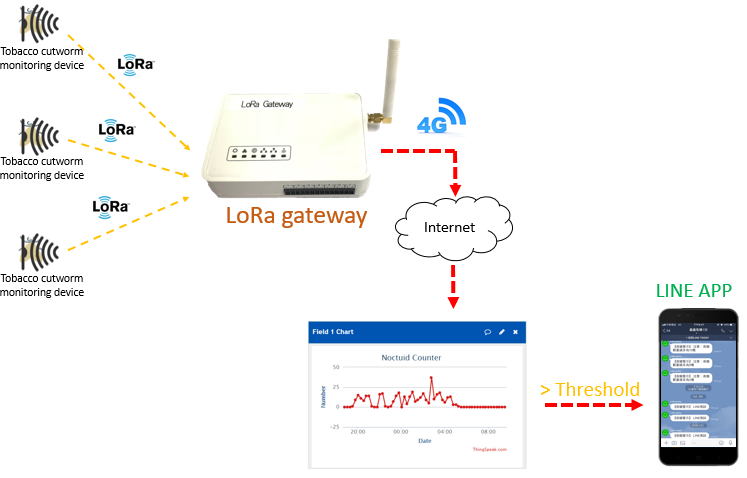Author:Chi-Ling Chen;Jheng-Hong Hu,Taiwan Agricultural Research Institute, COA
Introduction
The development of the Internet of Things (IoT) has brought people closer, such as the smart home, smart city, industry 4.0, etc. Its applications in agriculture also constantly develop to make it an indispensable part of modern smart agriculture.
Spodoptera litura Fabricius, also known as the tobacco cutworm, is a nocturnal and polyphagous pest that may come to be year-round, especially in the peak period from May to November. It reproduces rapidly, and the adult moth demonstrates strong environmental adaptation and migratory ability.In addition, the larvae have a large appetite and a wide range of feeding habits, posing harm to fruits and crops and resulting in serious losses in terms of yield and appearance. Therefore, Spodoptera litura Fabricius has been regarded as primary pest by agricultural department for long time, targets urgently in need of control and prevention. If tobacco cutworm can controlled and prevented before its mass-production, hazard which it created can be effectively inhibited. Hence, the monitoring of population quantity progress will remain key. In this study, infrared automatic count technology has been integrated into monitoring and pre-warning functions. Through the Internet, information of tobacco cutworm counts in each monitoring spots can be quickly transmitted. and announcements through the pest warning system are applied to achieve early prevention and control, prevent disaster area spread, and reduce losses incurred from agricultural disasters.
Architecture
With the characteristic of “lure-specificity pheromone attracting target male species”, a special-purpose connector ring made by 3D printing was installed on the lower part of the insect trap, and an infrared sensor was attached to the connector ring site. When the male tobacco cutworms pass through the collector mouth, infrared light will be block, and the device will automatically detect and record the number of tobacco cutworms that have passed (Fig.1), achieving the function of long-term monitoring of tobacco cutworm counts. The automatic count sensor was used by the Taiwan Agricultural Research Institute, Council of Agriculture, Executive Yuan in field tests from October to November 2018, which was supplemented by manual counting for comparison. The accuracy the automatic count sensor reached 80.5%.
Wireless Transmission Structure
 Fig. 2 Data transmission process.
Fig. 2 Data transmission process.By connecting the node of any object to the Internet, node information and its control can be obtained through the Internet, which is called Internet of Things (IOT). In recent years, the IoT technology has been applied to agriculture. The application of IoT in agricultural crop nodes often involves the use of an environmental or ecological monitoring sensor, which is connected to the Internet to achieve data automatic send-back, and real-time monitoring, improve the manual download sensor data on site, thereby substantially reducing manual costs. Spodoptera litura Fabricius monitoring devices set up the LoRa wireless local area network at each monitoring station through LoRa (Long Range) wireless transmission technology. Through the use of the transmission distance of 4km, long-distance transmission via the wireless local area network free of charge can be completed. Finally, the LoRa gateway receives all the data on the Spodoptera litura Fabricius monitoring device and sends the data to the cloud server by mobile communication (4G) connected to the Internet, thereby completing the data transmission process. Each monitoring station is only required to pay for one mobile communication (4G) fees to complete receiving all LoRa wireless transmission from Spodoptera litura Fabricius monitoring devices within 4km, which greatly cuts down mobile communication costs. Users only need a computer or smart phone to monitor the number of Spodoptera litura Fabricius on the website, as shown in Fig. 2.
Warning function
The tobacco cutworm monitoring system in this study still able to set “warning threshold” except receiving automatic count data from respective monitoring stations, When the quantity exceeds the threshold, notification that contained warning messages can be automatically push notification via communication App (LINE) to remind farmers in the area of pest to take preventive and control measures as soon as possible.
Conclusion
Precise and timely pest monitoring system development enhances effectiveness of pest prevention and control, and reduces the impacts of tobacco cutworms on crops. Integration of tobacco cutworm monitoring and pre-warning system by the IoT technology can replace current dependence on manpower needed to calculate tobacco cutworm numbers in the field. In addition, manpower costs and telecommunication expenses can be significantly reduced because LoRa wireless transmission and 4G mobile communication transmission was implemented. It is also expected that the system be slightly modified based on pest characteristics to be applied for the prevention and control of other pests.